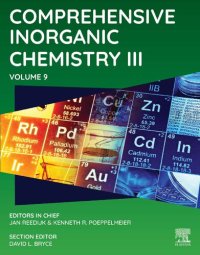
Ebook: Comprehensive Inorganic Chemistry III. Volume 9: NMR of Inorganic Nuclei
- Series: Comprehensive Inorganic Chemistry III
- Year: 2023
- Publisher: Elsevier
- Edition: 3
- Language: English
- pdf
Comprehensive Inorganic Chemistry III, a ten-volume reference work, is intended to cover fundamental principles, recent discoveries, and significant applications of elements and their compounds. Authored by renowned experts in the field and edited by a world-class editorial board, each chapter provides a thorough and in-depth overview of the topic covered, featuring resources which will be useful to students, researchers, faculty as well as those in the industry.
Comprehensive Inorganic Chemistry III focuses on main group chemistry, biological inorganic chemistry, solid state and materials chemistry, catalysis, and new developments in electrochemistry and photochemistry, as well as NMR and diffraction methods for studying inorganic compounds.
The work expands on our 2013 work Comprehensive Inorganic Chemistry II while also adding new volumes on cutting-edge research areas and techniques for studying inorganic compounds. Researchers seeking background information on a specific problem involving the synthesis of inorganic compounds, as well as applications for numerous elements from the periodic table, and their compounds, will be able to rely on and refer to this authoritative scientific resource time and again.
Nuclear magnetic resonance (NMR) spectroscopy has long been established as one of the most important analytical tools at the disposal of the experimental chemist. The isotope-specific nature of the technique can provide unparalleled insights into local structure and dynamics. As seen in the various contributions to this Volume, applications of NMR spectroscopy to inorganic systems span the gas phase, liquid phase, and solid state. The nature of the systems discussed covers a very wide range, including glasses, single-molecule magnets, energy storage materials, bioinorganic systems, nanoparticles, catalysts, and more. The focus is largely on isotopes other than 1H and 13C, although there are clearly many applications of NMR of these nuclides to the study of inorganic compounds and materials. The value of solid-state NMR in studying the large percentage of nuclides which are quadrupolar (spin I > ½) is apparent in the various contributions. This is perhaps to be expected given that rapid quadrupolar relaxation can often obfuscate the observation of these resonances in solution.
Comprehensive Inorganic Chemistry III focuses on main group chemistry, biological inorganic chemistry, solid state and materials chemistry, catalysis, and new developments in electrochemistry and photochemistry, as well as NMR and diffraction methods for studying inorganic compounds.
The work expands on our 2013 work Comprehensive Inorganic Chemistry II while also adding new volumes on cutting-edge research areas and techniques for studying inorganic compounds. Researchers seeking background information on a specific problem involving the synthesis of inorganic compounds, as well as applications for numerous elements from the periodic table, and their compounds, will be able to rely on and refer to this authoritative scientific resource time and again.
Nuclear magnetic resonance (NMR) spectroscopy has long been established as one of the most important analytical tools at the disposal of the experimental chemist. The isotope-specific nature of the technique can provide unparalleled insights into local structure and dynamics. As seen in the various contributions to this Volume, applications of NMR spectroscopy to inorganic systems span the gas phase, liquid phase, and solid state. The nature of the systems discussed covers a very wide range, including glasses, single-molecule magnets, energy storage materials, bioinorganic systems, nanoparticles, catalysts, and more. The focus is largely on isotopes other than 1H and 13C, although there are clearly many applications of NMR of these nuclides to the study of inorganic compounds and materials. The value of solid-state NMR in studying the large percentage of nuclides which are quadrupolar (spin I > ½) is apparent in the various contributions. This is perhaps to be expected given that rapid quadrupolar relaxation can often obfuscate the observation of these resonances in solution.
Download the book Comprehensive Inorganic Chemistry III. Volume 9: NMR of Inorganic Nuclei for free or read online
Continue reading on any device:

Last viewed books
Related books
{related-news}
Comments (0)